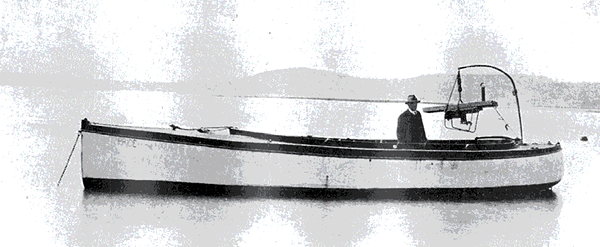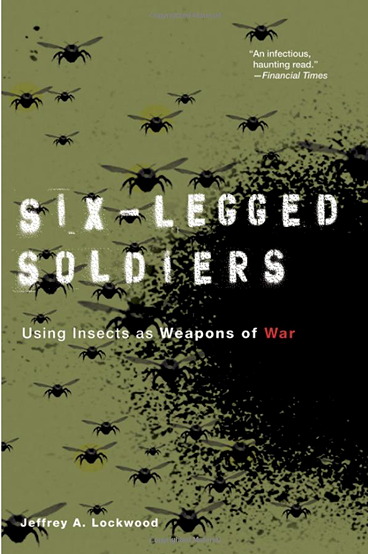Military
Tank Pigeons
Tanks were first used in combat during World War I, but they often relied on a very old-fashioned form of communication: pigeons.From military-history.org:

A pigeon about to be thrown from a tank during World War I
Posted By: Alex - Sun May 01, 2022 -
Comments (2)
Category: Animals, Military, War, 1910s
Anti-Submarine Seagulls
During World War I the British Navy attempted to train seagulls to reveal the presence of German submarines. The idea was to use a dummy periscope "from which at intervals food would be discharged like sausage-meat from a machine." The birds would, hopefully, learn to associate periscopes with food and would then fly around approaching German submarines, revealing where they were.Initial tests were conducted by Admiral Sir Frederick Inglefield in Poole harbour in Dorset. Inglefield tried to train the birds not only to fly around periscopes, but also to poop on them.
Subsequent tests were briefly conducted in 1917, but then the Navy abandoned the idea.
One private inventor, Thomas Mills, refused to give up on the idea. In 1918 he patented what he called an "apparatus for use in connection with the location of submarines" (Patent GB116,976). It was basically a dummy periscope that disgorged ribbons of food.
Unfortunately for Mills, the development of sonar then made submarine-detecting seagulls unnecessary.
More info: "Avian Anti-Submarine Warfare Proposals In Britain, 1915-18: The Admiralty And Thomas Mills," by David A.H. Wilson in the International Journal of Naval History - Apr 2006, 5(1).

Thomas Mills' seagull-training device

Mills and his invention
Posted By: Alex - Wed Apr 27, 2022 -
Comments (0)
Category: Military, Patents, 1910s
“Next” by Scott Walker
Although not the writer of the tune, Scott Walker really sells this tale of soldiers and hookers.
His Wikipedia page.
Posted By: Paul - Mon Nov 01, 2021 -
Comments (1)
Category: Military, Music, Sexuality, 1970s
Nuclear submarines as oil tankers
Potentially mad scheme: After the collapse of the Soviet Union, the Russian navy was casting about for ways to raise revenue and came up with the idea of using Typhoon-class submarines as oil tankers. The Soviets had built six Typhoon-class nuclear subs which were, and still are, the largest submarines ever made. The main selling point of this idea was that the subs could travel under Arctic ice, eliminating the need for expensive ice-breakers. From wikipedia:The idea was abandoned when someone over there decided that a nuclear sub filled with 10,000 tons of oil might pose some safety concerns.
More info: bellona.org

Posted By: Alex - Tue Mar 16, 2021 -
Comments (7)
Category: Military, Atomic Power and Other Nuclear Matters, Transportation, 1990s
Ghost Tape Number Ten
From Wikipedia:U.S. engineers spent weeks recording eerie sounds and altered voices, which pretended to be killed Viet Cong, for use in the operation, with the intended purpose of instilling a sense of turmoil within the enemy, the desired result being for the soldier to flee his position. The tape, dubbed Ghost Tape Number Ten, was played on loudspeakers outside U.S. bases.
Posted By: Alex - Wed Mar 10, 2021 -
Comments (4)
Category: Military, Paranormal, Cacophony, Dissonance, White Noise and Other Sonic Assaults
The Peanut Butter Story
As reported by Sherry Gershon Gottlieb in Hell No, We Won’t Go! Resisting the Draft During the Vietnam War:
via Legends & Rumors
Posted By: Alex - Fri Dec 18, 2020 -
Comments (4)
Category: Food, Military, Excrement
Demoralize Nazis with tea
1940: Stephens Fothergill of London had a very British plan to defeat the Nazis:
St. Louis Post-Dispatch - Feb 15, 1940
Posted By: Alex - Wed Oct 28, 2020 -
Comments (2)
Category: Military, War, 1940s
The collar saw of Carl Kusch
Carl Kusch of Germany invented a way that a person would never be without a saw when they needed one, because the saw could be worn around their neck at all times. From his 1909 patent:The invention consists in a flexible saw frame convertible at any time by suitable means into a rigid frame and which is so constructed that the saw blade can be put into the frame in the known manner, when the saw is used as a tool, or be fixed to the flat side of the frame when the frame is used as a guard. In the latter case the frame of the saw protects the dress or the body from contact with the saw blade.

Kusch evidently had high hopes for his invention, because he obtained patents for it in the United States, Great Britain, France, Switzerland, Austria, and Germany. Although in his patent he never explained who he thought was going to buy the thing. The military, I'm guessing, because it seems designed to be part of a German soldier's uniform. Although as far as I know, no army ever outfitted its soldiers with this thing.
Posted By: Alex - Sun Mar 22, 2020 -
Comments (7)
Category: Fashion, Inventions, Patents, Military, 1900s
The Man Can
Its formal name was the “man-carried auto-navigation device,” but it went by the nickname “Man Can.” The Martin-Marietta Corporation received patent no. 3,355,942 for it in 1967.It was a device designed to help soldiers avoid getting lost. The patent offered this description:

It combined a compass and a pedometer. A GI would record his initial location on a map, and then the device would track his footsteps and the directions in which he turned. When he was done walking, the device would tell him his new coordinates.
A key feature of the device was that it didn't use any battery power. So the GIs would never need to worry about it running out of juice. It operated via a bellows located in the heel of the GI's shoe.
I can't find any follow-up reports about how well this gadget worked. Apparently not well enough to warrant its adoption by the army. But it was an interesting concept.

Allentown Morning Call - Dec 11, 1967
Posted By: Alex - Sun Jan 05, 2020 -
Comments (4)
Category: Geography and Maps, Inventions, Patents, Military, Technology, 1960s
Project Capricious
During World War II, the OSS (precursor to the CIA) hatched a plan to defeat General Rommel's Afrika Korps by using synthetic goat poop. The idea was to drop huge amounts of pathogen-laced pseudo-poop over African towns. Local insects would be attracted to the stuff and would then carry the pathogens to Rommel's troops. However, before the plan could be carried out, Rommel's troops were withdrawn from the area and sent to Russia.Jeffrey Lockwood tells the story in more detail in his book Six-Legged Soldiers: Using Insects as Weapons of War.
The plan was to weaken the enemy forces by using flies to spread a witch's brew of pathogens. Given the agency's inability to rear an army of flies, [OSS Research Director] Lovell decided to conscript the local vectors...
Lovell was a chemist, but he'd been out of the laboratory often enough to know that flies love dung. And with a bit of research, he discovered a key demographic fact: There were more goats than people in Morocco — and goat are prolific producers of poop. Lovell now had the secret formula: microbes + feces + flies = sick Germans. Now all he needed was a few tons of goat droppings as a carrier for laboratory-cultured pathogens.
The OSS collaborated closely with the Canadian entomological warfare experts to launch one of the more preposterous innovations in the history of clandestine weaponry: synthetic goat dung. Of course flies are no fools; they won't be taken in by any old brown lump. So the OSS team added a chemical attractant. The nature of this lure is not clear, but a bit of sleuthing provides some clues.
Allied scientists might have crafted a chemical dinner bell by collecting and concentrating the stinky chemicals that we associate with human feces (indole and the appropriately named skatole). While these extracts would have worked, the more likely attractant was a blend of organic acids, some of which had been known for 150 years. Two of the smelliest of these are caproic and caprylic acids, which, by no coincidence, derive their names from caprinus, meaning "goat." Etymologically as well as entomologically astute, Lovell named the operation Project Capricious. So with a scent to entice the flies, Lovell's team then coated the rubbery pellets in bacteria to complete the lures.
All the Americans had to do was drop loads of pathogenic pseudo-poop over towns and villages where the Germans were garrisoned, and millions of local flies would be drawn to the bait, pick up a dose of microbes, and then dutifully deliver the bacteria to the enemy. Lovell worried about keeping the operation clandestine. The Moroccans had to be persuaded that finding goat droppings on their roofs the morning after Allied aircraft flew over was a sheer coincidence. Presumably a good disinformation campaign can dispel almost any suspicion, or, as Lovell intimated, if the plan succeeded there would be very few people in any condition to raise annoying questions about fecal pellets on rooftops...
In the end, however, Lovell didn't have to worry about getting caught by either friends or foes, as the secret weapon was never deployed. Just as the OSS was gearing up to launch the sneak attack, the German troops were withdrawn from Spanish Morocco. They might well have preferred to take their chances with pathogen-laden flies, given that Hitler was sending them to the bloody siege of Stalingrad.

Posted By: Alex - Sat Jul 20, 2019 -
Comments (5)
Category: Insects and Spiders, Military, War, Weapons, Excrement, 1940s

| Who We Are |
|---|
| Alex Boese Alex is the creator and curator of the Museum of Hoaxes. He's also the author of various weird, non-fiction, science-themed books such as Elephants on Acid and Psychedelic Apes. Paul Di Filippo Paul has been paid to put weird ideas into fictional form for over thirty years, in his career as a noted science fiction writer. He has recently begun blogging on many curious topics with three fellow writers at The Inferior 4+1. Contact Us |




